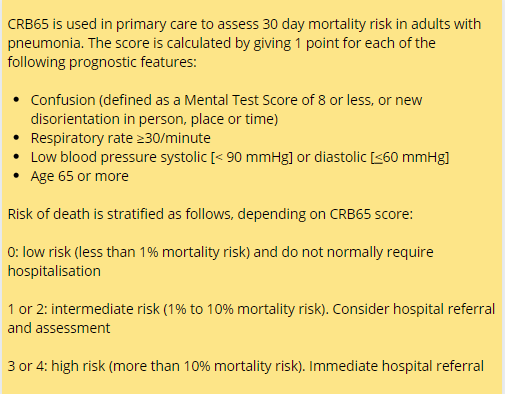Comments from the Expert Advisory Committee
- Community acquired pneumonia (CAP) is a pneumonia that is acquired outside hospital.
- CAP in the community can been defined as:
- Symptoms of an acute lower respiratory tract illness (cough and at least one other lower respiratory tract symptom)
- New focal chest signs on examination
- At least one systemic feature (either a symptom complex of sweating, fevers, shivers, aches and pains and/or temperature of 380C or more)
- Start antibiotics immediately
- Review if symptoms are not improving as expected with antibiotics and escalate therapy, or consider hospital referral.
- Assess severity using the CRB-65 score.

- The need for hospital referral should be assessed, and at review, re-assessed using the CRB65 criteria.
- At convalescence, ensure COVID-19, influenza and pneumococcal vaccinations up to date.
Treatment Table - Community Acquired Pneumonia
| Community Acquired Pneumonia (Adults): Antibiotic Treatment Table |
|
Assess using the CRB-65 score (each symptom or sign scores one point)
(Confusion, Respiratory rate ≥ 30/min, BP ≤ 90/60 mmHg, Age ≥ 65) |
|
CRB 65 Score Zero (0) Suitable for home treatment
Review if symptoms are not improving as expected with antibiotics and escalate therapy, or consider hospital referral. |
| Amoxicillin |
500mg every 8 hours
|
5 days |
Avoid in penicillin allergy.
If no response after 48 hours on Amoxicillin monotherapy, consider addition of Clarithromycin or change to Doxycycline |
| OR Doxycycline |
200mg every 24 hours* |
5 days |
Avoid in pregnancy.
Advise to take with a glass of water and sit upright for 30 minutes after taking.
Can take with food or milk if gastritis is an issue.
Absorption of doxycycline significantly impaired by antacids, iron/calcium/magnesium/zinc-containing products. |
| OR Clarithromycin (Second line in penicillin allergy) |
500mg every 12 hours |
5 days |
Macrolides should be used with caution in pregnancy. Clarithromycin suitable only in 2nd and 3rd trimester in pregnancy. Alternative macrolide for all trimesters of pregnancy: Azithromycin 500mg stat then 250mg every 24 hours from Day 2 to Day 5. |
|
CRB 65 Score 1-2 and assessed suitable for treatment in the community
Review if symptoms are not improving as expected with antibiotics and escalate therapy, or consider hospital referral. |
|
Amoxicillin
PLUS
Clarithromycin |
500mg - 1g every 8 hours
500mg every 12 hours |
5 days |
Avoid amoxicillin in penicillin allergy.
Macrolides should be used with caution in pregnancy. Clarithromycin suitable only in 2nd and 3rd trimester in pregnancy. Alternative macrolide for all trimesters of pregnancy: Azithromycin 500mg stat then 250mg every 24 hours from Day 2 to Day 5. |
| OR Doxycycline |
200mg every 24 hours* |
5 days |
Avoid in pregnancy.
Advise to take with a glass of water and sit upright for 30 minutes after taking.
Can take with food or milk if gastritis is an issue.
Absorption of doxycycline significantly impaired by antacids, iron/calcium/magnesium/zinc-containing products. |
| CRB 65 Score 3 or more : urgent hospital admission |
| Administer Benzylpenicillin prior to transfer |
1.2g IV/IM |
N/A
|
Avoid in penicillin allergy
Urgent hospital admission
Seek risk factors for Legionella and Staph.aureus infection |
|
Or
Amoxicillin |
1g PO |
N/A
|
*Alternative doxycycline dose: 100mg every 12 hours.
In non-severe infection, 200mg stat then 100mg every 24 hours can be considered.
- Pleuritic pain should be relieved using simple analgesia, and consider pulmonary embolism.
- Consider advising patients on hydration and smoking cessation where appropriate.
- Consider time off work for patients with CAP dependent on clinical assessment.
- Advise to consult pharmacist for symptom relief.
Patient Information
Reviewed May 2022
